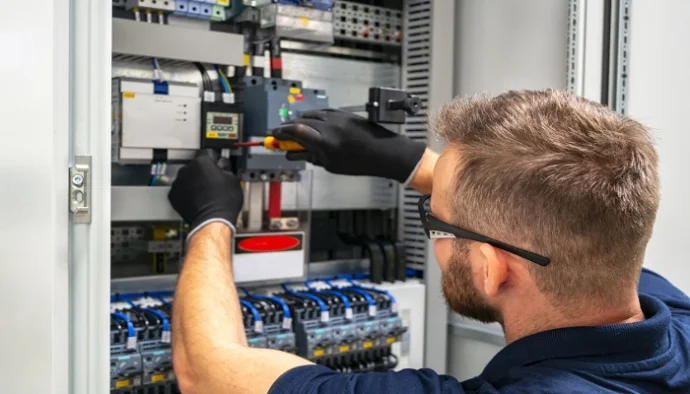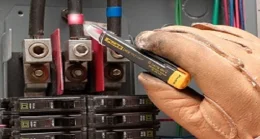How A UPS Maintenance Bypass Switch Installation Reduces Downtime
Uninterruptible power supplies are installed as ‘in-series’ devices between their connected loads and the mains power supply. The use of an external maintenance bypass arrangement allows the UPS to be withdrawn from service without disruption to the connected loads.
Internal UPS Maintenance Bypass Switch
Most hard-wired UPS systems from 10kVA upwards (single and three phase) typically incorporate a UPS maintenance bypass arrangement. This forms part of the hardwired input/output cable assembly and may be accessible from behind a front or rear panel on the UPS system. Whilst this type of bypass switch isolates the UPS for the local service engineer there is still AC (alternating current) running through the UPS bypass section. If the UPS must be completely power down for removal, the loads will experience downtime.
External UPS Maintenance Bypass Switch
An external maintenance bypass can form part of the LV distribution side of the electrical installation for an uninterruptible power supply. The device is typically wall mounted and for some smaller single-phase UPS systems may also be available as a rack mount device. Connections to and from the UPS bypass are generally hardwired to:
- The mains power supply
- The input and output of the UPS system
- To the connected loads via a sub-distribution panel
Small single-phase UPS bypass switches may offer ‘plug-and-play’ connections using IEC-style sockets. Whether the bypass switch is hardwired or not, the device may also include a local UK-style socket for use by the UPS service engineer to plug-in their laptop or other AC powered device.
The actual bypass switch itself may be a rotary switch or set of circuit breakers. The switches or breakers may be off the break-before-make (BBM) or make-before-break (MBB) type. MBB provide zero transfer time from mains to bypass and bypass to mains. BBM type switches will have a break from 2-4milliseconds or greater. This may not be sufficiently long enough to trouble the power supplies built-into modern IT servers but could affect sensitive scientific equipment.
For remote interfacing the UPS bypass switch may also include signal contacts (normally volt-free). These can be connected to a local building management system or data centre infrastructure management (DCIM) system for remove monitoring. The bypass device may also include Castel interlocking to prevent accidental switch operation out of sequence with the connected loads. Castel interlocking can also be incorporated into Centralised and Decentralised bypass arrangements.
Automatic Bypasses
On-line UPS will include an automatic bypass switch, and this is to protect the UPS should there be a fault condition or overload. A sensing circuit monitoring the output of the UPS monitors for a short-circuit or collapsing voltage and current waveform. If this is detected the bypass automatically routes the load to the mains power supply until the fault is removed. Most UPS systems can take a 110-120% overload for a short period before an overload condition causes the automatic transfer.
For smaller on-line UPS systems, the automatic bypass will be relay based and have a transfer time of typically 2-4milliseconds. For larger and three-phase UPS the bypass should be a solid-state static bypass with zero load supply interruption.
The automatic bypass should not be considered as anything other than a safe ‘failure-to-mains’ device. It is not intended for maintenance or emergency service and will not lead to any part of the UPS being isolated for safe working. All component and subassemblies will be live unless the UPS is shutdown completely is isolated by way of an internal maintenance bypass or external version.
UPS and Maintenance Bypass Switch Installations
Uninterruptible power supplies for critical loads should always be installed with an external maintenance bypass switch. Sometimes the switch is referred to as a service panel or service bypass. The words ‘maintenance’ and ‘service’ really do identify when this product is of most use. There will come a point during the life of the UPS system when it will require complete electrical isolation and potentially removal. This could be during a preventative maintenance visit or an emergency service call-out.
A UPS maintenance bypass should be selected at the same time as the UPS system as it must match the input and output voltages and configuration of the UPS. Bypasses are typically built to suit an installation format whether this is 1/1, 3/1 or 3/3 i.e. single (1) or three (3) phases input and/or output. This aspect can also be important when upgrading a UPS system. Care must be taken to prevent a mismatch in wiring, phase rotation or polarity.
Bespoke UPS Maintenance Bypass Panels
Where a monoblock UPS is installed in an N+X configuration a bespoke bypass panel will be required. In the UK, LV switchboard manufacturers can typically provide a bespoke bypass arrangement either as a ‘one-off’ or as part of a batch production line. Whilst most bypass panels are black or charcoal coloured to match their UPS system, bespoke manufacturers also typically offer a choice of colours painted in their own or subcontract workshops. Bespoke panels can also include further metering and options including lighting and surge protection.
Summary
In a critical power installation an external UPS maintenance bypass is always recommended. The bypass will prevent disruption to the connected loads during each preventative maintenance visit and could help to achieve a fast, on-site repair or swap out during an emergency call out. The bypass can also assist with mains failure simulations and load bank testing of the UPS is there is a test facility.
Where there is the need for extensive electrical works, the maintenance bypass switch can always be sent ahead and installed ready for a final ‘tails’ connection and commissioning of the UPS system.

























